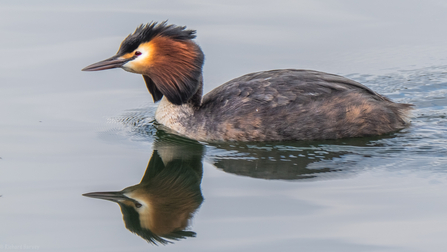When you arrive at Lackford one of the first things you may notice is the sheer number of singing birds dotted around the reserve. Song thrush, blackbird, robin, dunnock, wren, blue tit and sometimes mistle thrush are spending large parts of their day setting up territories and trying to attract females.
Early signs of spring at Lackford Lakes
Robin singing by Mike Andrews
dunnock singing by Mike Andrews
At the moment, all the birds you hear are likely to be year-round residents so now is a good chance to get to know birdsong a bit better, before the influx of migrants that will soon begin and and will complicate the picture a little!
Out on the Lakes it’s not just what you can hear but also what you can see- there are several pairs of great-crested grebes well into the elaborate courtship displays that they use to build a bond with each other. Each display can take several hours and involves much copying of the bird opposite- diving, head-waving, neck-bobbing and the giving of mutual edible gifts such as duckweed dredged up from the lake floor- no need for a box of chocolates if you’re a great-crested grebe at Lackford! The displays often culminate in both birds facing each other and touching bellies as they rise up out of the water, as if they were standing on their webbed feet. It’s amazing to watch and the best places to look are the Sailing Lake, Long Reach (viewable from Bess’s Hide) and Steggall’s Hide, where they have also been beginning nest building.

great crested grebe by Rick Harvey
Love is also in the air for our ducks- several species are now displaying regularly. Goldeneye have the most dramatic performance- stretching their necks up, then suddenly throwing their heads back as if broken, and making an otherworldly rasping sound as they follow the females around. Hawker Pool and Sailing Lake are best for these. On the Slough drake teal are busy whistling to the females and making sure the females catch sight of their beautiful bottle-green and chestnut head pattern. You may look at a drake gadwall and think he has drawn the short straw- but although he is a more subtle mixture of grey and black, he cleverly turns suddenly in the water so that the sunlight glints off his feathers and catches the females’ eye. Other ducks such as mallard, wigeon and pochard are beginning to think about the coming breeding season too.
We believe we now have our very first migrant bird on site, in the form of the chiffchaff- heard singing yesterday (9th March) and seen today by Derek’s Hide. This date beats last year (13th March) but not quite 2017 (4th March). Another bird that visits us at this time is the oystercatcher, and there are pairs staking their watery claim out on the reserve- one pair on the Slough, one at Long Reach and two down at Steggall’s. You may well hear them before you see them given the racket they make at this time!
oystercatchers by Mike Andrews
So, as we sit somewhere between winter and spring here at Lackford, it’s a really interesting time of year to visit. You can still easily see our winter visitors like redpoll and siskin (on the Centre feeders) as well as goldeneye (out on Sailing Lake or Hawker Pool) but the first creatures of spring are making themselves known too. We now have four butterfly species confirmed as seen here this year- brimstone (14th Feb), comma (22nd Feb), with peacock and red admiral two days later (24th). Even on cooler, cloudier days bees are becoming a common sight again, with chunky queen bumblebees seeking out new nest sites and honeybees and hoverflies joining them as they feast on the willow catkins around the Kingfisher Trail.
bee on willow by Mike Andrews

